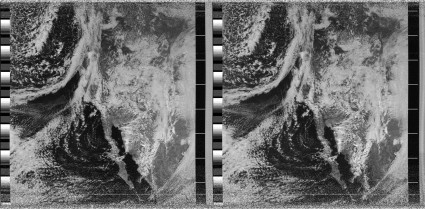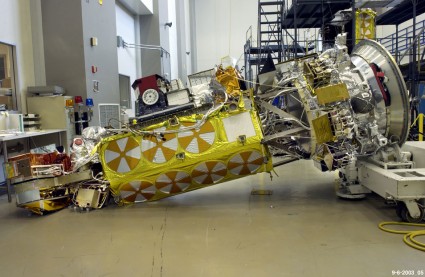Update: If you do a search for NOAA 19 on google, this blog post actually makes it to the front page. Some of you might be looking for information as to how you can listen for it. I use a Radio Shack Pro-60 scanner, tuned to 137.9125 Mhz, set in WFM mode, and my hand held antenna. I’ll try to make a video of my complete setup soon, and link it here… Now, back to the original posting.
Well, not really it’s first picture, but the first picture that I received. NOAA-19 is the last of the U.S. series that will transmit APT imagery, which is the simple analog format that I can receive using my super cheap setup. It’s also the satellite that was badly damaged during tested when the technicians failed to secure it before tilting it, resulting in millions in damage. It was finally launched on February 6th.
Anyway… here’s the picture, one of my better ones! It looks like both images are sending the same data here (I understand the satellite is still in testing mode).
Pass was recorded Feb 8, 2009, beginning around 21:18 UTC.
Addendum: Here’s the picture of the satellite accident.


Nice image, mine don’t look quite as nice. What software are you using for this?
73
Eric / WY7USA
I’m using some software that I wrote myself. Someday, when I remove some of the more embarrassing parts of the code, I’ll be releasing it as open source. It doesn’t do anything sophisticated (no colorization, no map overlays) but it does produce nicely aligned images without any user intervention. I record the satellite pass as a 16 bit .wav file using an 11025Hz sample rate, and it outputs an image. No interface, just a command line.
Perhaps its not the software, but the radio. I have been using an 857d with the WXToImg software and I always thought the bandwidth was a bit tight for WX images. I just ordered an 817 this weekend and wonder if that might make a difference.
Anyhow, I will try to copy another satellite tonight and see how it well it works.
73
Eric / WY7USA
Eric, this will make you laugh then. I have used two different radios to record satellites well. The first is a Radio Shack Pro 60 scanner, the second is my Yaesu VX-3R. I use them both in WFM mode, which is really way too wide, but at least it doesn’t clip.
When I first started doing this, I did some tests, like this one.
It starts out in narrow mode. You can see lots of clipping etc. then, I shift to narrow band, and you can see a lot more dynamic range.
I am not 100% sure how WXtoImg works with narrow band receivers, but I suspect that it is using a zero crossing demodulator while tuning in DIGITAL/SSB mode. That will work, but isn’t as good as using a wider receive bandwidth.
Hello. My photos (http://www.noaa.2o.pl/big/20090209134643.png) NOAA 19 received by the receiver F6BQU.
http://lpistor.chez-alice.fr/meteo2.htm#recepteur + antenna QFH.
Szymon
SQ6NDM
Hi Liked the pictures
Please check out the ones on my site – Using a home made QFH (Quadrifilar Helix Antenna) and Timestep Pro Scan and a R2FX receivers
Just found out today, May 30th 2009, that NOAA-19 was in orbit. I wish it a long life as well as
the 15, 17 and 18 birds. I’ll miss the simple 120 LPM mode when its gone. I’ve used many
inexpensive scanners to receive the images but in the early 90’s I paid the price and bought a
WEPIX 2000B receiver from Vanguard Electronics. It is made specifically for NOAA reception and
gives noticeably better inages. I have tried many antennas. I’m limited to what I can put in a small
attic. A homebrew QFH that cost nearly nothing to construct has been the best. And, I’ve used
many software packages. The software that worked best for me for image decoding is
WXTOIMG http://www.wxtoimg.com there is a free version at their website. I went ahead and
bought a license. It uses the computer’s sound card. For tracking the sats I’m using a program
called ORBITRON which, I believe, is free with donations accepted. It will track anything you can
get TWO-LINE Kepler data for. Used it the other week to track the Hubble Telescope during the
shuttle repair mission and it agreed with the NASA maps I saw on internet TV at Mission Control.
Today I used my 40M amateur radio dipole antenna and my FT-817ND transceiver just to see if
I could hear NOAA-19 and I did. The FT-817 and-or the FT-857 will receive the LEO birds but
they are poor equipment for that purpose. I have had better images from inexpensive Radio
Shack scanners. A simple modification for narrow bandwidth receivers is to bypass their
ceramic filters with a small value, perhaps 50pF, capacitor. It worked for me. That web site
mentioned is in French and I only know about 5 words in French but looks awfully interesting.
Anyway, just a bunch of comments…. But I will continue to enjoy APT mode while it lasts.
StarDotStar
Receiving19 only intermittenly. seems to start and stop. using Time Step Proscan, all other sats OK. any ideas.
I’ve been creating wide composite images from various stations in EU and NA. Have a look at http://widecomposite.w0mm.com
Hello,
I use a Timestep Proscan receiver, it does not receive the NOAA 19 signals, at 137.925, I will try to contact Quartslab.com for a crystal for it, but can i access the circuit board to fit a crystal? And what is the right fitting for it, I dont have a manual for the receiver.